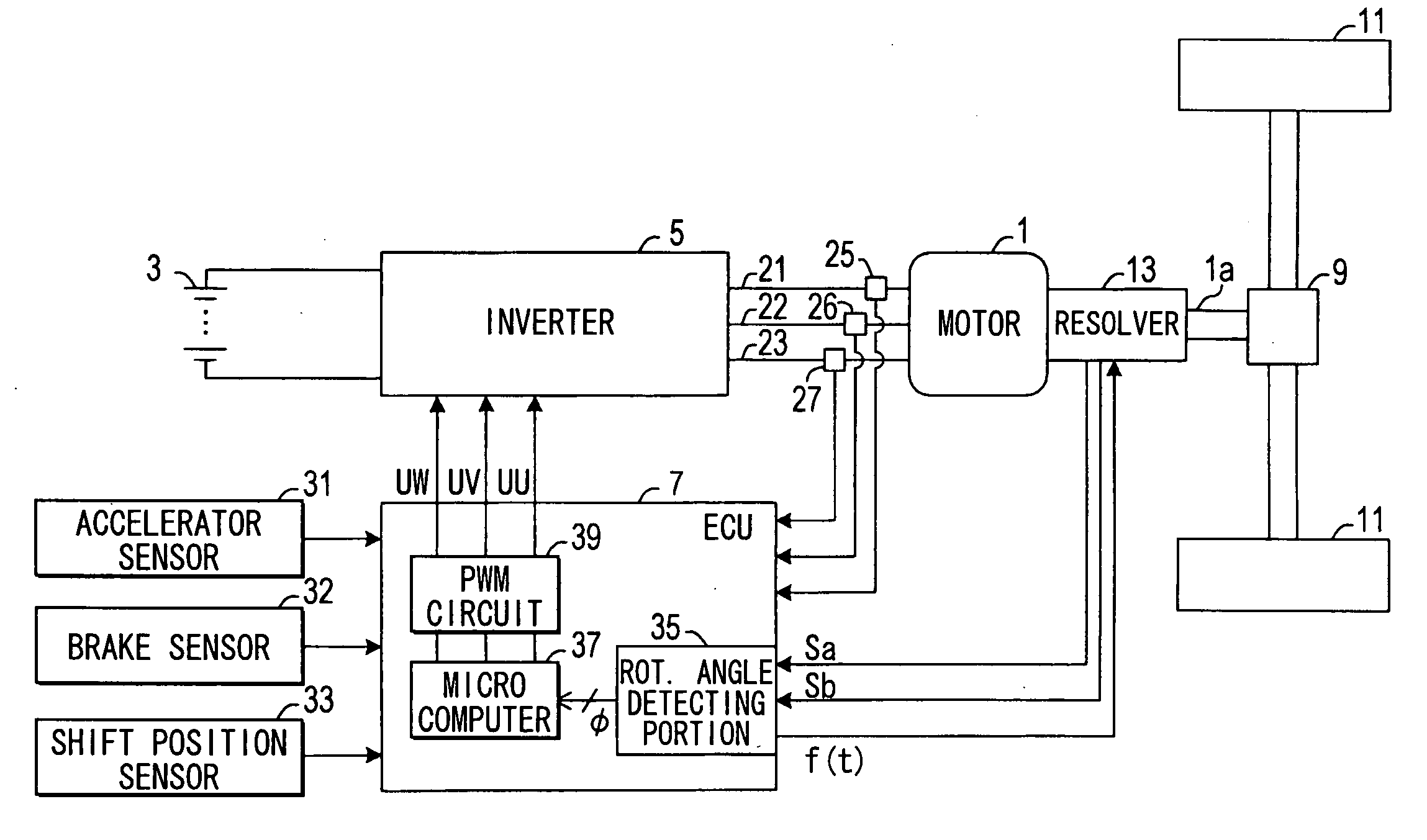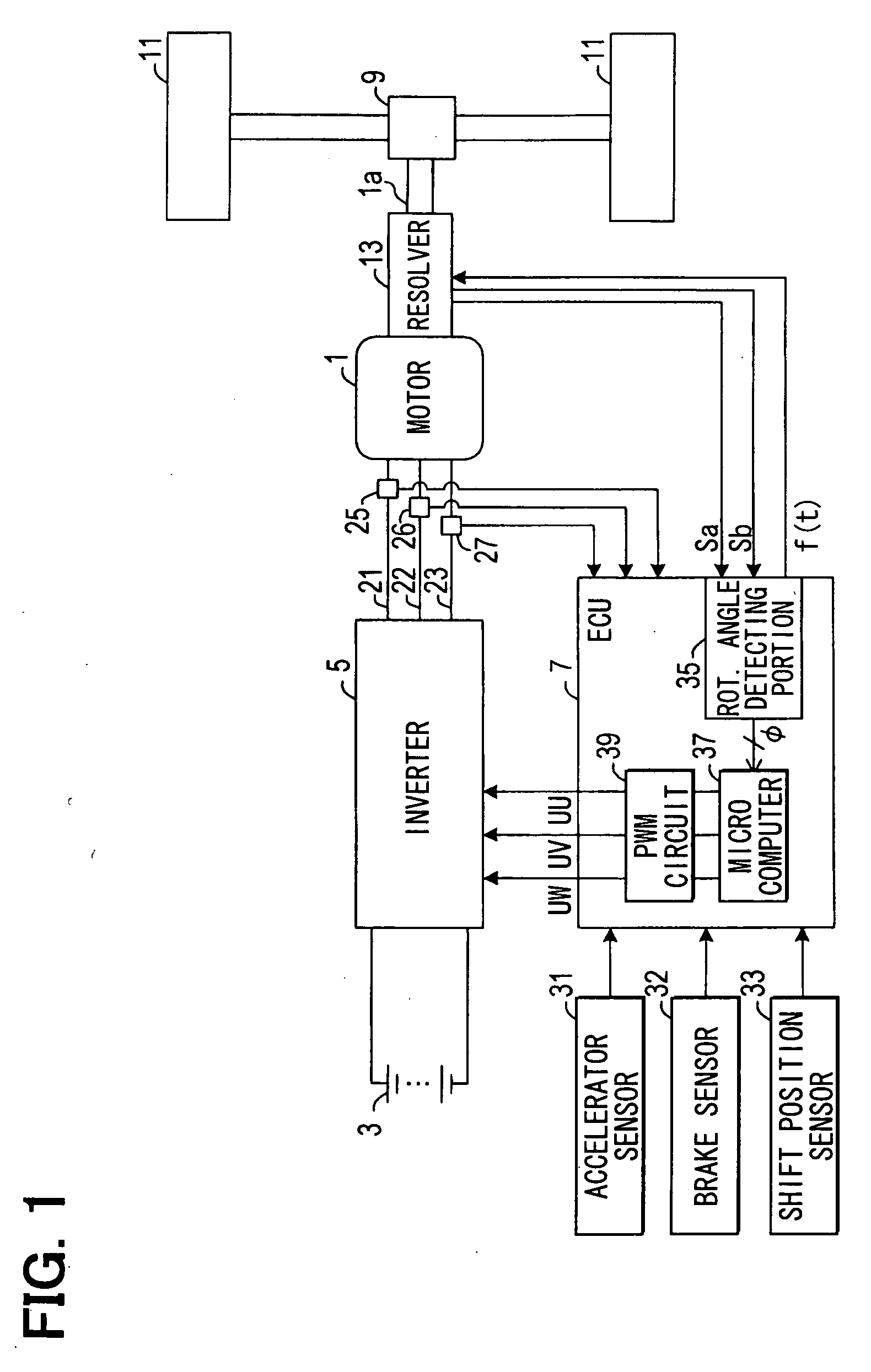[0018]To achieve the objective of the present disclosure, there is also provided a motor control system for a vehicle, wherein the motor control system includes a motor, a rotation sensor, and a controller. The motor provides a drive power. The rotation sensor is configured to outptit reference angle information every time the motor rotates a reference angle. The rotation sensor is configured to output actual detected angle information every time the motor rotates constant unit angle that is smaller than the reference angle. The actual detected angle information indicates an actual detected angle of rotation of the motor measured based on output timing, at which the reference angle information is outputted. The controller is coupled to the rotation sensor and the motor. The controller receives the actual detected angle information and the reference angle information from the rotation sensor. The controller outputs a control command of controlling energization to the motor, wherein the controller includes an estimated pulse generator, a counter, and a memory. The estimated pulse generator is coupled to the rotation sensor. The estimated pulse generator measures duration of one cycle of the reference angle information every time the reference angle information is outputted. The duration is measured between a previous time, at which the reference angle information is previously outputted, and a current time, at which the reference angle information is currently outputted. The estimated pulse generator computes an estimated time, which is required for the motor to rotate the unit angle in subsequent rotation of the motor, based on the duration. The estimated pulse generator generates an estimated pulse based on the estimated time. The counter is coupled to the rotation sensor and the estimated pulse generator. The counter computes an estimated angle of rotation of the motor, which is measured based on the output timing of the reference angle information, by counting the estimated pulse every time the counter receives the estimated pulse under an assumption that the motor rotates the unit angle while the estimated time elapses. The counter outputs estimated angle information that indicates the estimated angle. The memory stores therein a plurality of first differences of a plurality of representative angles. One of the plurality of first differences of the plurality of representative angles is stored every time the actual detected angle indicated by the actual detected angle information becomes a corresponding one of the plurality of representative angles during the one cycle of the reference angle information. The plurality of representative angles includes a final angle that corresponds to a final value of the actual detected angle. The one of the plurality of first differences indicates an advance amount of the estimated angle relative to the actual detected angle. The memory further stores therein a plurality of second differences of a plurality of angular sections. The plurality of second differences is computed based on the plurality of first differences of the plurality of representative angles stored in the memory. One of the plurality of angular sections is defined between an initial value of the actual detected angle at the output timing of the reference angle information and a minimum representative angle of the plurality of representative angles. The other one the plurality of angular sections is defined between adjacent ones of the plurality of representative angles. Each of the plurality of second differences indicates an exceeding amount of an increase amount of the estimated angle relative to an increase amount of the actual detected angle within a corresponding one of the plurality of angular sections. The memory further stores therein a plurality of learning values of the plurality of angular sections. The plurality of learning values is computed by adjusting the plurality of second differences stored in the memory in accordance with one of the plurality of first differences computed at the final angle. The controller outputs an initialization command, an output updating command, and a correcting command. In initialization command, a value of corrected angle information, which indicates a corrected angle of rotation of the motor, is set to the initial value when the reference angle information is outputted. In the output updating command, the value of the corrected angle information by a certain value, which corresponds to the unit angle, is increased based on the output timing of the reference angle information every time the actual detected angle information is outputted. In the correcting command, an increase amount of the value of the corrected angle information, which is increased while the actual detected angle changes within each of the plurality of angular sections, is increased by a corresponding one of the plurality of learning values of the plurality of angular sections stored in the memory. The controller outputs the control command, which is computed based on the corrected angle information, to the motor.
[0019]To achieve the objective of the present disclosure, there is also provided a motor control system for a vehicle, wherein the motor control system includes a motor, a rotation sensor, and a controller. The motor provides a drive power. The rotation sensor is configured to output reference angle information every time the motor rotates a reference angle, the rotation sensor is configured to output actual detected angle information every time the motor rotates a constant unit angle that is smaller than the reference angle. The actual detected angle information indicates an actual detected angle of rotation of the motor measured based on output timing, at which the reference angle information is outputted. The controller is coupled to the motor and the rotation sensor. The controller has therein a memory. The controller is configured to measure duration of one cycle of the reference angle information every time the reference angle information, is outputted. The duration is measured between a previous time, at which the reference angle information is previously outputted, and a current time, at which the reference angle information is currently outputted. The controller computes an estimated time, which is required for the motor to rotate the unit angle in subsequent rotation of the motor, based on the duration. The controller is configured to compute estimated angle information every time the estimated time elapses under an assumption that the motor rotates the unit angle while the estimated time elapses. The estimated angle information indicates an estimated angle of rotation of the motor measured based on the output timing of the reference angle information. The controller is configured to compute one of a plurality of first differences of a plurality of representative angles every time the actual detected angle indicated by the actual detected angle information becomes a corresponding one of the plurality of representative angles during the one cycle of the reference angle information. The one of the plurality of first differences indicates a difference between the estimated angle and the actual detected angle. The controller is configured to compute a plurality of second differences of a plurality of angular sections based on the plurality of first differences of the plurality of representative angles. One of the plurality of angular sections is defined between an initial value of the actual detected angle at the output timing of the reference angle information and a minimum representative angle of the plurality of representative angles. The other one of the plurality of angular sections is defined between adjacent ones of the plurality of representative angles. Each of the plurality of second differences indicates a difference between an increase amount of the actual detected angle and an increase amount of the estimated angle within a corresponding one of the plurality of angular sections. The controller is configured to store each of the plurality of second differences in the memory in association with the corresponding one of the plurality of angular sections. The controller is configured to compute a plurality of learning values by adjusting the plurality of second differences in accordance with a degree of acceleration and deceleration of the motor. The controller is configured to initialize a value of the corrected angle information, which indicates a corrected angle of rotation of the motor, when the controller receives the reference angle information. The controller is configured to increase the value of the corrected angle information by a value corresponding to the unit angle every time the actual detected angle information is outputted. The controller is configured to increase an increase amount of the value of the corrected angle information within each of the plurality of angular sections by a value indicated by a corresponding one the plurality of learning values. The controller is configured to control the motor based on the corrected angle information.
[0020]To achieve the objective of the present disclosure, there is also provided a computer-readable medium having computer-executable instructions for performing a method. In the method, reference angle information is obtained from a rotation sensor every time a motor rotates a reference angle. Actual detected angle information is obtained from the rotation sensor every time the motor rotates a constant unit angle that is smaller than the reference angle. The actual detected angle information indicates an actual detected angle of rotation of the motor measured based on output timing, at which the reference angle information is outputted. Duration, of one cycle of the reference angle information is measured every time the reference angle information is outputted. The duration is measured between a previous time, at which the reference angle information is previously outputted, and a current time, at which the reference angle information is currently outputted. An estimated time, which is required for the motor to rotate the unit angle in subsequent rotation of the motor, is estimated based on the duration. Estimated angle information is computed every time the estimated time elapses under an assumption that the motor rotates the unit angle while the estimated time elapses. The estimated angle information indicates an estimated angle of rotation of the motor measured based on the output timing of the reference angle information. One of a plurality of first differences is computed every time the actual detected angle indicated by the actual detected angle information becomes a corresponding one of a plurality of representative angles during the one cycle of the reference angle information. The plurality of representative angles includes a final angle that corresponds to a final value of the actual detected angle. The one of the plurality of first differences indicates a difference between the estimated angle and the actual detected angle. A plurality of second differences of a plurality of angular sections is computed based on the plurality of first differences of the plurality of representative angles. One of the plurality of angular sections is defined between an initial value of the actual detected angle at the output timing of the reference angle information and a minimum representative angle of the plurality of representative angles. The other one of the plurality of angular sections is defined between adjacent ones of the plurality of representative angles. Each of the plurality of second differences indicates a difference between an increase amount of the actual detected angle and an increase amount of the estimated angle within a corresponding one of the plurality of angular sections. Each of the plurality of second differences is stored in a storage part in association with the corresponding one of the plurality of angular sections. The plurality of second differences stored in the storage part is adjusted in accordance with a degree of acceleration and deceleration of the motor. A value of corrected angle information to the initial value is initialized when the
 Login to View More
Login to View More  Login to View More
Login to View More 


